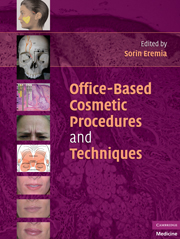Book contents
- Frontmatter
- Contents
- PREFACE
- CONTRIBUTORS
- PART ONE ANATOMY AND THE AGING PROCESS
- PART TWO ANESTHESIA AND SEDATION FOR OFFICE COSMETIC PROCEDURES
- Chap. 2 LOCAL ANESTHETICS
- Chap. 3 THE CONCEPT OF TUMESCENT ANESTHESIA
- Chap. 4 NERVE BLOCKS
- Chap. 5 TOPICAL ANESTHESIA
- PART THREE FILLERS AND NEUROTOXINS
- PART FOUR COSMETIC APPLICATIONS OF LIGHT, RADIOFREQUENCY, AND ULTRASOUND ENERGY
- PART FIVE OTHER PROCEDURES
- INDEX
- References
Chap. 3 - THE CONCEPT OF TUMESCENT ANESTHESIA
from PART TWO - ANESTHESIA AND SEDATION FOR OFFICE COSMETIC PROCEDURES
Published online by Cambridge University Press: 06 July 2010
- Frontmatter
- Contents
- PREFACE
- CONTRIBUTORS
- PART ONE ANATOMY AND THE AGING PROCESS
- PART TWO ANESTHESIA AND SEDATION FOR OFFICE COSMETIC PROCEDURES
- Chap. 2 LOCAL ANESTHETICS
- Chap. 3 THE CONCEPT OF TUMESCENT ANESTHESIA
- Chap. 4 NERVE BLOCKS
- Chap. 5 TOPICAL ANESTHESIA
- PART THREE FILLERS AND NEUROTOXINS
- PART FOUR COSMETIC APPLICATIONS OF LIGHT, RADIOFREQUENCY, AND ULTRASOUND ENERGY
- PART FIVE OTHER PROCEDURES
- INDEX
- References
Summary
Tumescent anesthesia is used today for various surgical procedures on the skin. Although most commonly used for liposuction and for harvesting fat for use as an autologous filler, the technique has been applied to various other procedures, including laser resurfacing, laser tattoo removal, endovenous ablation of varicose veins, and various medical and cosmetic surgical procedures. Tumescent anesthesia is achieved by injecting relatively large volumes of dilute neutralized lidocaine solution with epinephrine into the subcutaneous tissue. Tumescent anesthesia allows procedures that previously required conscious sedation or general anesthesia to be performed more safely, while patients are awake or mildly sedated. Commonly, it decreases or eliminates the need for narcotic analgesics or IV sedation for many cosmetic procedures. Tumescent lidocaine solutions have also been attributed antibacterial effects, possibly accounting for the very low rate of infection seen with tumescent liposuction. The use of dilute epinephrine in the tumescent solution further increases the safety of procedures, including liposuction, by decreasing blood loss. When used for resurfacing procedures, distending the skin can better expose the base of wrinkles to the resurfacing procedure.
Tumescent anesthesia, which revolutionized liposuction, was developed in the mid-1980s by dermatologic surgeon Dr. Jeffery Klein, who was able to demonstrate that lidocaine serum levels remained within safe limits following the injection of what were then considered high doses of lidocaine in terms of milligrams per kilogram, while at the same time achieving excellent anesthetic effect, if the lidocaine was delivered as large volumes of very dilute (0.05%) solution into fatty tissue.
- Type
- Chapter
- Information
- Office-Based Cosmetic Procedures and Techniques , pp. 15 - 16Publisher: Cambridge University PressPrint publication year: 2010



